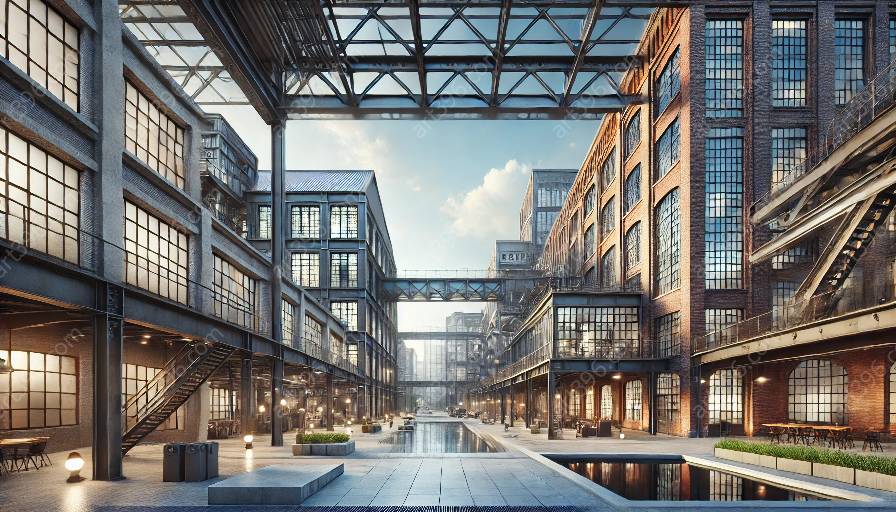Industrial architecture plays a crucial role in ensuring the safety and security of manufacturing facilities. It encompasses a range of design and planning strategies that are specifically tailored to address the unique challenges and requirements of industrial settings, ultimately contributing to the protection of workers and the prevention of potential hazards.
The Role of Industrial Architecture in Ensuring Safety and Security
Industrial architecture integrates various elements to create a safe and secure environment within manufacturing facilities. This includes the careful consideration of building materials, structural design, layout, and technological advancements. These elements work together to establish a framework that mitigates risks and safeguards the well-being of individuals involved in industrial operations.
Structural Integrity and Material Selection
One of the fundamental contributions of industrial architecture to safety and security is the focus on structural integrity and material selection. This involves the use of durable and resilient materials that can withstand the demands of industrial processes, as well as extreme environmental conditions. By incorporating materials resistant to fire, corrosion, and other potential hazards, industrial architects can reduce the likelihood of structural failures and enhance the overall safety of the facility.
Efficient Layout and Spatial Planning
Efficient layout and spatial planning are essential components of industrial architecture that directly impact safety and security. These design aspects aim to optimize workflow, minimize congestion, and ensure clear pathways for the movement of personnel and materials. Adequate space allocation for different operational zones and the strategic positioning of essential facilities, such as emergency exits, fire suppression systems, and safety equipment, are critical considerations that help to prevent accidents and facilitate swift responses in the event of emergencies.
Incorporation of Advanced Technologies
Furthermore, industrial architecture embraces the incorporation of advanced technologies to enhance safety and security measures. This includes the integration of surveillance systems, access control systems, environmental monitoring systems, and automated safety protocols. By leveraging these technological advancements, manufacturing facilities can significantly bolster their ability to detect potential threats, monitor critical parameters, and implement proactive measures to protect personnel and assets.
Enhancing Worker Protection and Well-being
Beyond the physical infrastructure, industrial architecture also focuses on creating environments that prioritize the well-being and protection of workers. Elements such as natural lighting, ventilation systems, and ergonomic design principles are integrated to promote optimal working conditions and reduce the risk of occupational hazards. Additionally, thoughtful consideration is given to factors such as noise control, thermal comfort, and the provision of rest areas, all of which contribute to maintaining a safe and conducive workplace environment.
Environmental Sustainability and Risk Mitigation
Industrial architecture is increasingly aligned with principles of environmental sustainability and risk mitigation. By implementing sustainable design practices, such as the incorporation of energy-efficient systems, renewable materials, and waste management strategies, manufacturing facilities can minimize their environmental impact while simultaneously improving safety and security. Through the application of risk assessment methodologies, industrial architects can identify potential threats, assess their potential impact, and develop tailored solutions to mitigate these risks, thereby bolstering the overall resilience of the facility.
Regulatory Compliance and Industry Standards
Another vital aspect of industrial architecture's contribution to safety and security is adherence to regulatory compliance and industry standards. Industrial architects are tasked with ensuring that the design and construction of manufacturing facilities align with relevant safety regulations, codes, and standards. By upholding these requirements, industrial architecture not only promotes a culture of safety and responsibility but also safeguards against legal and operational risks, ultimately enhancing the overall security of the facility.
Conclusion
In conclusion, industrial architecture plays a pivotal role in contributing to the safety and security of manufacturing facilities. From the selection of robust materials to the strategic layout and integration of advanced technologies, the considerations and decisions made by industrial architects directly impact the protection of workers, the prevention of accidents, and the overall resilience of industrial environments. By prioritizing efficient design, environmental sustainability, and regulatory compliance, industrial architecture stands as a critical enabler for ensuring the well-being and security of individuals within manufacturing facilities.





























































